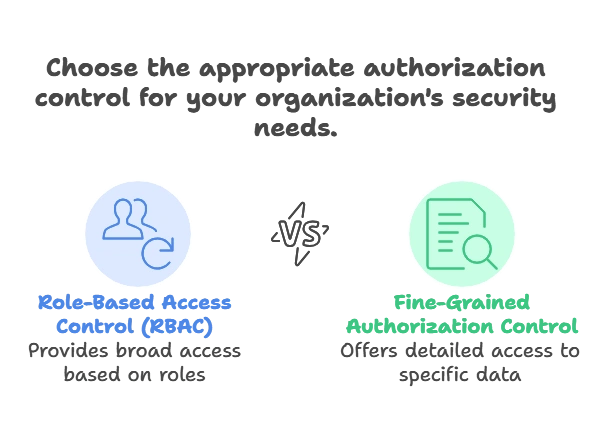Fine-Grained Authorization Control in MongoDB
Fine-grained authorization control is a method for managing access to specific data at a granular level. In MongoDB, fine-grained authorization control is essential for applications that handle sensitive data, where it’s critical to limit what users or roles can do within the database.
What is Fine-Grained Authorization Control?
Fine-grained authorization control is a security approach that limits user access to specific data and operations, ensuring only authorized users can perform certain actions. It goes beyond basic role-based access control (RBAC) by allowing detailed permissions down to individual documents and fields. This control is crucial for organizations handling sensitive information, enabling compliance with data protection standards and minimizing unauthorized access.

Role-Based Access Control (RBAC) in MongoDB
RBAC is a method for managing access permissions based on user roles. MongoDB uses RBAC as a core security feature, and it’s the foundation for implementing fine-grained control. With RBAC, you define roles that include specific permissions and assign these roles to users.
Components of RBAC in MongoDB:
- Roles: Collections of privileges that grant specific actions on resources.
- Users: Individuals or applications assigned roles for controlled access.
- Privileges: Allowances that specify actions (e.g.,
read,write,dbAdmin) on specific resources.
User and Role Management
In MongoDB, managing users and roles involves creating users and assigning them roles to determine their level of access to the database.
Creating Users
MongoDB provides the createUser command for defining users with specific roles.
Example:
db.createUser({
user: "reportUser",
pwd: passwordPrompt(), // Request user to enter password securely
roles: [
{ role: "read", db: "salesData" }
]
})
This example creates a user named reportUser with read access to the salesData database.
Assigning Roles to Users
Each user can have multiple roles, allowing for varied permissions. By assigning roles with different privileges, MongoDB can control access at different levels.
Modifying User Roles Example
db.updateUser("reportUser", {
roles: [
{ role: "readWrite", db: "salesData" }
]
})
Here, the reportUser role is updated to have readWrite access on salesData.
Privilege Assignments and Actions
Privileges in MongoDB define what actions a user can perform on a specific resource (databases, collections, or even documents). Fine-grained privileges limit these actions to the exact operations needed.
Common Privileges:
- Read: Allows users to read data.
- Write: Enables users to insert, update, or delete data.
- dbAdmin: Grants administrative actions like creating indexes or validating collections.
Example Privilege Assignment
{
role: "customRole",
privileges: [
{ resource: { db: "salesData", collection: "transactions" }, actions: [ "find", "insert" ] }
],
roles: []
}
This example creates a custom role customRole that allows find and insert actions on the transactions collection within the salesData databas
Document-Level and Field-Level Access Control
MongoDB enables document- and field-level access control, where permissions can be enforced down to individual documents or even specific fields within a document.
Document-Level Access Control
Using MongoDB’s query-based access control, you can restrict users to accessing only specific documents based on query filters.
Example of Document-Level Access:
Suppose you want users to access only documents related to their assigned department in the employees collection.
{
role: "departmentViewRole",
privileges: [
{
resource: { db: "companyDB", collection: "employees" },
actions: [ "find" ],
filter: { department: "sales" } // Access only for department "sales"
}
]
}
Field-Level Access Control
Field-level control ensures that users can view only specific fields in documents. MongoDB currently lacks direct field-level access control but encourages using aggregation pipelines to restrict output fields.
Example Using Aggregation for Field Restrictio
db.employees.aggregate([
{ $match: { department: "sales" } },
{ $project: { name: 1, department: 1 } } // Only returns name and department fields
])
Auditing Access and Compliance
Auditing access in MongoDB involves tracking database operations to monitor who accessed specific data and when. MongoDB provides an auditing feature to log actions taken by users with various roles, useful for compliance and security monitoring.
Example Audit Event: MongoDB logs events such as authCheck, dropDatabase, insert, etc., which are crucial for understanding user actions and enforcing accountability.
Implementing Custom Roles for Fine-Grained Access
To set up tailored roles that match specific access needs, MongoDB supports custom roles. These roles are useful when built-in roles do not cover the exact requirements.
Creating a Custom Role
db.createRole({
role: "limitedAccessRole",
privileges: [
{ resource: { db: "sensitiveDB", collection: "customerData" }, actions: [ "find" ] }
],
roles: []
})
Here, limitedAccessRole allows users to view (find) documents in the customerData collection but restricts them from modifying data.
Assigning the Custom Role to a User
db.createUser({
user: "limitedUser",
pwd: passwordPrompt(),
roles: [
{ role: "limitedAccessRole", db: "sensitiveDB" }
]
})
This limitedUser now has limitedAccessRole with access restricted to customerData viewing only.
Best Practices for Fine-Grained Authorization
- Use the Principle of Least Privilege: Assign users only the permissions they need to perform their job functions.
- Separate Duties: Avoid assigning powerful roles, like
dbAdminorclusterAdmin, to regular users. - Implement Custom Roles: Create custom roles to provide precise access control.
- Regularly Review and Audit Roles: Regular audits help ensure that access remains secure.
- Use Aggregation to Control Field-Level Access: Use MongoDB’s aggregation pipelines to project only necessary fields.
Fine-grained authorization control in MongoDB provides a secure and flexible way to manage access, from databases to individual fields. By using MongoDB’s role-based access control, custom roles, document-level filters, and careful auditing, administrators can achieve granular control over who can access data, ensuring compliance and security in sensitive applications. Happy coding !❤️
